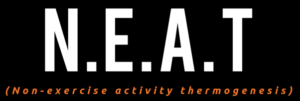In pursuit of a healthier lifestyle, we often prioritize structured exercise, such as workout classes, running, or weightlifting. These activities undoubtedly contribute to our well-being, but there’s a subtle yet often overlooked approach to staying active: incidental physical activity.
Energy Expenditure Beyond the Gym
Non-Exercise Activity Thermogenesis (NEAT) encompasses the energy we expend through unstructured activities. From sleeping and grocery shopping to gardening and doing laundry, NEAT encompasses a wide array of actions. It also makes up nearly three-quarters of our daily energy expenditure. Various factors make up an individual’s NEAT, including ambient temperature, height, weight, fat mass versus fat-free mass, occupation, working hours, stress levels, sleep patterns, and time spent participating in structured exercise.
Seizing Opportunities for Movement
The evidence is clear: the more we move, the better our chance of avoiding health complications as we age. Prolonged periods of sitting lead to muscle inactivity and poor blood circulation. Just three hours of continuous sitting can trigger notable reductions in arterial function. Prolonged sitting can increase the risk of health complications like diabetes, heart disease or high cholesterol in the long-term.
A Little Goes a Long Way
Even small changes can make a substantial difference when it comes to breaking up periods of sedentary time. Research shows that doing just three minutes of resistance exercises or light walking every 30 minutes of prolonged sitting can have a significant impact on your health. The results showed that for adults with poor adherence to structured exercise programs, interrupting prolonged sitting with brief periods of movement is a practical way to increase physical activity levels.
Another study looked the role of short activity breaks during periods of sitting for glucose responses and diabetes management following food intake. There were three groups involved with this research. The first group were completely sedentary after consuming a standardised carbohydrate-based drink. The second group incorporated two-minute bouts of light intensity walking every 20 minutes after consuming the drink. The third group walked for two-minutes at a moderate intensity every 20 minutes.
The results showed that breaking up sitting with two minutes of light walking reduced blood glucose by 24.1%. Those who did moderate intensity walking saw an average reduction in their blood glucose levels of 29.6%. For those individuals who find walking difficult or painful, performing air punches or alternative upper limb activities can help attain similar improvements.
Practical Tips for Increasing Incidental Activity
Elevating your daily movement doesn’t demand an overhaul of your routine. Simple shifts can drive significant results:
- TV Time: Include some activity while watching TV. Combine it with light activities like ironing to burn an additional 50-100 kcal/hour.
- Stand and Work: Consider a standing desk to counteract prolonged sitting. Alternatively, set alarms to stand up briefly every hour. This can also help to reduce persistent pain that can be associated with sedentary occupations.
- Lunch Break: Utilize your lunch hour for going on a walk and ‘kill two (or three) birds with one stone’. Expend some energy, refresh the brain, and get some vitamin D, all at once!
- Active Meetings: Take phone call meetings while out on a walk.
- Sneak in Movement: While waiting for mundane task such as brushing your teeth or waiting for the kettle or microwave, use these as reminders to sneak in some calf raises, push ups, squats, or balance exercises.
- Set Reminders: Use reminders to break up sedentary periods, placing them in spots where you often sit like a post-it note. Apps like ‘Rise & Recharge’ or a timer can also be helpful.
Incidental activity isn’t just for people who aren’t performing regular structured exercise. Exercise and physical activity go hand in hand, and both occupy an important section of the Australian Guidelines for Physical Activity. So, regardless of whether you have ticked off your daily exercise or not, we can all benefit from sitting less and moving more!




